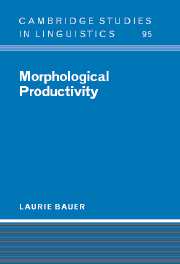2 - A historiographical conspectus
Published online by Cambridge University Press: 22 September 2009
Summary
[M]ere mention of the subject [sc. productivity] seems to be taken by many as an open invitation to anecdotalism.
Aronoff (1976: 35)[P]roductivity and listedness are not grammatical concepts.
Di Sciullo and Williams (1987: 2)Productivity and its synonyms
Although the terms ‘productive’ and ‘productivity’ appear to be relatively new, the concepts in the form in which they have been outlined in chapter 1 are old. As Schultink (1992a: 188) points out, the whole notion of grammar implicit in the work of the Sanskrit grammarians assumes the idea of productivity. This idea has been available to English grammarians at least since Palsgrave's Lesclaircissement de la langue francoyse was published in 1530. As Stein (1999: 62) says more generally of this work, ‘the concepts were there, but not yet the terms for them’, so that Palsgrave discusses affixes such as English -ness as being ‘certayne’ in their application (cited in Stein 1999). The term ‘productivity’ is much more recent. As far as Schultink has been able to discover, the term is first used by Dietz (1838: 221), who says that
Die meisten und wichtigsten Bildungsformen dagegen sind kraft ihrer wohl gefühlten Bedeutung lebendig und produktiv geblieben. [Most formative elements, and the most important of these, on the other hand, have remained living and productive on account of their strongly-felt meaning. My translation, LB.]
- Type
- Chapter
- Information
- Morphological Productivity , pp. 11 - 32Publisher: Cambridge University PressPrint publication year: 2001



